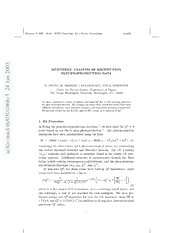
Multipole Analysis of Recent Pion Electroproduction Data PDF
Preview Multipole Analysis of Recent Pion Electroproduction Data
February8,2008 23:10 WSPC/TrimSize: 9inx6inforProceedings nstar02 3 0 0 MULTIPOLE ANALYSIS OF RECENT PION 2 ELECTROPRODUCTION DATA n a J 4 R. ARNDT,W. BRISCOE, I. STRAKOVSKY,ANDR.WORKMAN 2 Center for Nuclear Studies, Department of Physics The George Washington University, Washington, D.C. 20052 3 v 8 We have performed a series of global and single-Q2 fits to the growing database 6 forpionelectroproduction. Wecomparetosomeotherrecentfitswhichhaveused 0 differentformalisms,moreselectivedatasets,andtruncatedmultipoleexpansions. 1 WepresentresultsfortheE2/M1andS2/M1ratios,asafunctionofQ2. 0 3 0 / 1. Fit Procedure h t In fitting the pion electroproduction database 1, we have fixed the Q2 = 0 - cl point based on our fits to pion photoproduction 2. The photoproduction u multipoles have been parametrized using the form n : M = (Born+α )(1+iT )+α T +(ImT −T2 )(αH+iαH), (1) v B πN R πN πN πN r i i X containing the Born terms, with phenomenological pieces (α) maintaining r the correct threshold behavior and Watson’s theorem. The πN T-matrix a (T ) connects each multipole to structure found in the elastic πN scat- πN tering analysis. Additional structure is parametrized through the Born terms (which contain vector-mesoncontributions), and the phenomenolog- ical structure functions (α , α , αH, and αH). B R r i At non-zero Q2, the Born terms have built-in Q2 dependence, other terms have been modified by a factor f(Q2)= k 1 e−ΛQ2 1+αQ2+β W −1 , k(Q2 =0)(1+Q2/0.71)2 (cid:18) (cid:20)W (cid:21)(cid:19) R (2) where k is the photon CM momentum, Λ is a universal cutoff factor, and the constants, α and β, are searched for each multipole. We have per- formed energy and Q2-dependent fits over the full kinematic range [W to 1.7GeVandQ2 to5(GeV/c)2 ]inadditiontofittingdataclusteredaround particular Q2 values. 1 February8,2008 23:10 WSPC/TrimSize: 9inx6inforProceedings nstar02 2 Figure1. Energy-angledistributionofπ0pandπ+nelectroproductiondata: Q2=0.40, 0.50,0.65,0.75,0.90,1.15,1.45,and1.80(GeV/c)2 associatedwithJLabCLASπ0pQ2 binningforsingle-Q2 results. February8,2008 23:10 WSPC/TrimSize: 9inx6inforProceedings nstar02 3 Figure 2. E2/M1 and S2/M1 ratios vs Q2. Values were extracted from our fixed Q2 analyses startingon the global fit(filled squares) usingworldand JLab CLASdata 3. ResultsfromRef. 3(filledcircles)aregiven. Inaddition,(leftpanel),ourpionphotopro- ductionresult(Q2 =0) 2 (filledasterisk),and(rightpanel),thedataofRefs. 4 (open triangle)and5 (opendiamond)areshown. Thesolidcurvesgiveourglobal(energyand Q2 dependent) best-fit results. Dash-dotted and dashed curves arefromRefs.6 and 7, respectively. Figure 3. Total cross sec- tionforπ0pelectroproduction, showingthevariationwithQ2. AscanbeseeninFigure1,thereisrelativelylittleπ+ndataatmoderate Q2. As a result, some analyses actually quote a ratio of E2/M1 for the π0p charge channel, rather than the isospin 3/2 component, assuming a negligible isospin 1/2 part at the ∆-resonance. 1.1. Data Reduction Afittodistributionsinθ andφcanbemademoreefficientifthesymmetry σ(φ) = σ(360−φ) is used. Let σ1 = σ(φ), σ2 = σ(360−φ), and z be the statisticalerror(squared). Ifwetakeσ tobe the fittedvalue,thenforeach February8,2008 23:10 WSPC/TrimSize: 9inx6inforProceedings nstar02 4 Figure 4. Differential cross section for π0p electroproduc- tion, showing the φ depen- dence. Dataarefrom 3. Figure 5. Q2 dependence of the magnetic (M1+), electric (E1+), and scalar (S1+) multipoles,forisospin3/2. pair of φ values we have χ2 = (σ−σ1)2 + (σ−σ2)2, (3) z1 z2 which can be written as χ2 = (σ1−σ2)2 + (σ−σa)2, (4) z1+z2 za February8,2008 23:10 WSPC/TrimSize: 9inx6inforProceedings nstar02 5 where σa = (z1σ2+z2σ1)/(z1+z2) is the weighted average of σ1 and σ2, and z is given by a 1 1 1 = + . (5) za z1 z2 Using the form given in Eq. (4), only half of the data points are required in the fitting routine, the first term being a constant which measures the internal consistency of a given set. For the set of π0p data given in Ref. 3, forexample,thefirstterminEq.(4)contributesaχ2of15040forthe12528 φ pairs. 2. Results In Figures 2− 5, we compare our result to MAID 6, Sato-Lee 7, and single-Q2fitsperformedbytheJeffersonLabCLAS3 Collaboration. Below 2 (GeV/c)2, there is considerable scatter, with SAID and MAID extrapo- lating to an E2/M1 zero-crossing; no crossing being seen in Sato-Lee. As indicatedabove,the higher-Q2 regionis sparselypopulated. Inour fits,we find thatthe inclusionofadditionalpreliminarydata canshift the crossing point significantly, but a crossing always occurs. This is in particular dis- agreement with the 4 (GeV/c)2 Hall C value 8, and details of the various fits, at this kinematic point, are being studied in more detail. Acknowledgments This work was supported in part by a U. S. Department of Energy Grant No.DE–FG02–99ER41110. We alsoacknowledgeacontractfromJefferson Lab under which part of this work was done. Jefferson Lab is operated by the Southeastern Universities Research Association under DOE contract DE–AC05–84ER40150. References 1. R. A. Arndt, I. I. Strakovsky, and R. L. Workman, πN Newsletter, 16, 150 (2002). 2. R.A.Arndt,W.J. Briscoe, I. I.Strakovsky,and R.L.Workman, Phys. Rev. C 66, 055213 (2002). 3. K.Joo et al. (The CLAS Collaboration), Phys. Rev. Lett. 88, 122001 (2002). Werestrict our fitsto bins havingmore than 5 eventsper bin. 4. Th. Pospischil et al.,Phys. Rev. Lett. 86, 2959 (2001). 5. F. Kalleicher et al.,Z. Phys. A359, 201 (1997). February8,2008 23:10 WSPC/TrimSize: 9inx6inforProceedings nstar02 6 6. The extended version of the MAID analysis refers to DMT2001 http://www.kph.uni-mainz.de/MAID/. See also S. S. Kamalov, S. N. Yang, D. Drechsel, O. Hanstein, and L. Tiator, Phys. Rev. C 64, 032201 (2001); D. Drechsel, O. Hanstein, S. S. Kamalov, and L. Tiator, Nucl. Phys. A645, 145 (1999). 7. T. Sato and T. S.H. Lee, Phys. Rev. C 63, 055201 (2001). 8. V.V. Frolov et al. Phys. Rev. Lett. 82, 45 (1999).
